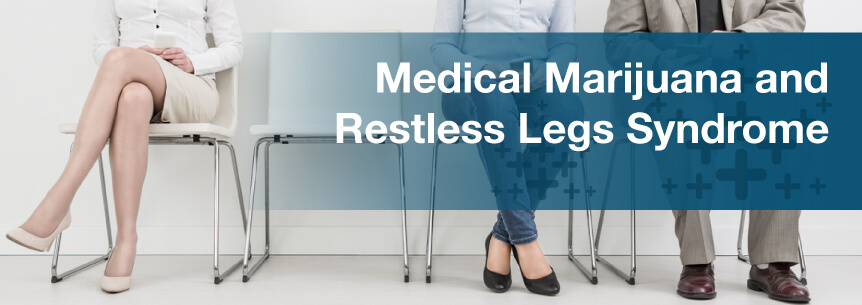
Restless legs syndrome is a condition the National Institute of Neurological Disorders and Stroke estimates affects between seven and 10 percent of the U.S. population. While both men and women may have restless legs syndrome, women are more likely to have the condition. Also called Willis-Ekbom Disease and Wittmaack-Ekbom’s Syndrome, restless legs syndrome (RLS) causes discomfort in the legs, along with a compulsion to move them.
You may find some relief from the symptoms of RLS by getting up and walking around, or by considering the treatment methods described below, including medical marijuana for restless legs syndrome.
Today, many experts recognize cannabis as a potential and legitimate treatment option for various diseases. Patients are now experimenting with medical marijuana for RLS when other traditional treatments are causing negative side effects, are too costly or are not working.
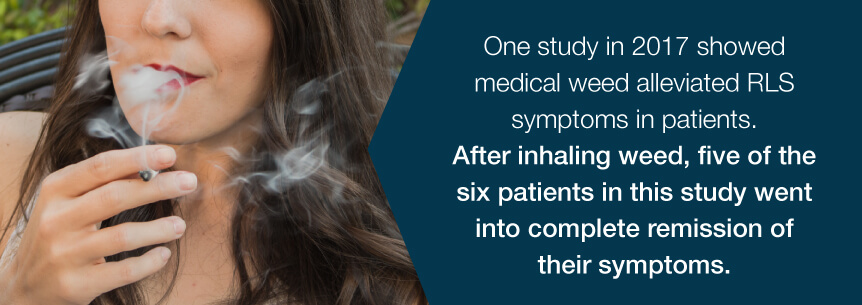
In fact, one study in 2017 showed medical weed alleviated RLS symptoms in patients. After inhaling weed, five of the six patients in this study went into complete remission of their symptoms. One patient reported they experienced total relief after they consumed the non-psychoactive compound cannabidiol (CBD) found in the herb. All six patients found substantial improvements in their quality of sleep with cannabis and restless legs syndrome therapy.
Find A Doctor Find A Dispensary
While it’s not approved by the Food and Drug Administration for medical indications, and there are little to no clinical trials or studies on using medical cannabis in RLS at the time of this writing, patients are providing anecdotal evidence about their experiences with the herb and their RLS-related symptom improvements.
Medical cannabis for restless legs syndrome works primarily by acting on the brain’s cannabinoid receptors to offer psychoactive effects on areas including coordination, pain relief and motor activity by restricting prostaglandin biosynthesis and thereby obstructing pain receptor pathways.
Although you may think it’s just a minor complaint, if it interferes with your sleep, RLS can bring on long-term, serious health problems. When you lack sleep, it can result in many issues, such as:
For those suffering from RLS, the night can be an agonizing experience. You may find yourself experiencing hours of undesirable leg sensations that keep you awake and cause you to toss and turn in your bed just about every night.
Insomnia is a common side effect of RLS that can potentially affect your daily life significantly. Using marijuana for restless legs syndrome can help with insomnia related to this constant tossing and turning. It offers you a useful alternative to avoid some of the adverse side effects of other types of treatment.
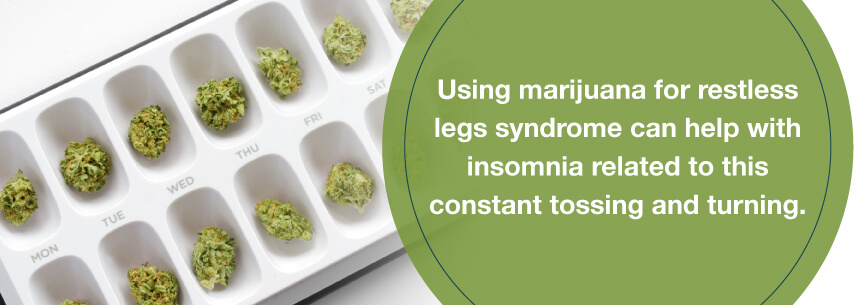
Both of medical pot’s major cannabinoids, tetrahydrocannabinol (THC) and CBD, demonstrate effectiveness in various studies intended for improving sleep and managing pain.
Cannabis for restless legs syndrome can make you sleepy and relieve your anxiety, enhancing its pain-relieving properties.
If you’re experiencing abnormal sensations when sitting still or lying down, or you find it nearly impossible to resist the urge to move your legs, there’s a good chance you’re suffering from RLS. These abnormal sensations may include:
If you’re dealing with insomnia because of your RLS, you may benefit from using medical pot strains high in THC. The following strains can help with RLS symptoms.
Other potent strains for RLS include:
If you’re seeking fast RLS symptom relief, inhaling your marijuana and restless legs syndrome treatment may be better. However, if you require longer-lasting relief, and don’t mind waiting a little bit for the effects to kick in, tinctures or edibles are the way to go. Micro-dosing may suit you, but it could take some experimenting before you find the proper administration amount and method.
If RLS keeps you up every night, exploring medical marijuana for restless legs syndrome may be an efficient and affordable alternative therapy choice for you to alleviate your symptoms and help you get the sleep your body needs. At Marijuana Doctors, we can assist you in finding the right cannabis doctor in your state, if you live in a state where medical weed is legal.
We have a thorough sleep disorder guide, including restless legs syndrome, to help you understand how medical pot works so you can use it as a way of tackling your symptoms of insomnia.
Cannabis offers so many patients a better choice at treating their symptoms, no matter what their condition is. It just takes a simple search in our medical cannabis doctor database. You’ll find a list of qualified, prescribing physicians to begin your cannabis for restless legs syndrome treatment as soon as possible.
Are you ready to join the medical marijuana program in your state? Let our professionals help you finally get the right treatment. We’ll save you time and take away the hassle of having to do all the research by yourself. Schedule your appointment today with a medical marijuana doctor.
Find A Doctor Find A Dispensary
Restless legs syndrome is a neurological disorder affecting anyone, at any age, though it often worsens as you age. It is a common condition, affecting more people than Type 2 diabetes.
Since many of the symptoms of RLS worsen in the evening, it often disrupts sleep. As a result, many people who have restless legs syndrome have a significantly diminished quality of life.
While there is no cure for restless legs syndrome, there are a variety of treatment methods, coping mechanisms and resources for support for people like you who are trying to live with RLS.
The symptoms of restless legs syndrome typically feel more pronounced when you are in a state of rest, such as sitting down to watch television or when you are trying to sleep at night.
Many people describe the symptoms of RLS as twitchiness in the legs. Others liken the condition to the sensation of ants crawling through their legs or carbonation running through their veins, according to the National Sleep Foundation. Simply put, RLS symptoms may appear as the following:
The severity and frequency of RLS symptoms vary from one patient to the next. While most people who have restless legs syndrome find relief from the symptoms by moving around, in severe cases, even being active may not improve the sensations.
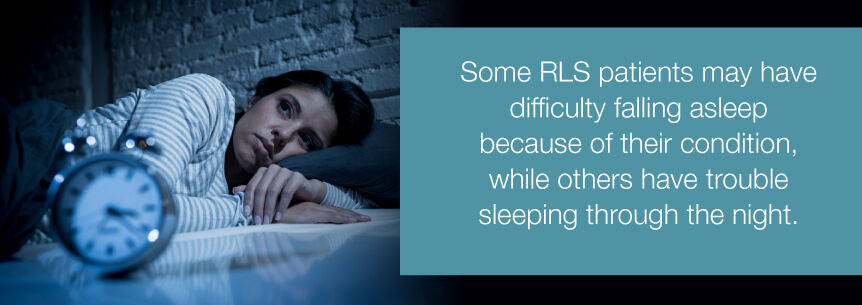
Some RLS patients may have difficulty falling asleep because of their condition, while others have trouble sleeping through the night. In moderate cases, patients may experience sleep disruptions once or twice a week. Unfortunately, this is enough time to impair your ability to function during the day.
The exact cause of RLS is unknown. There are several conditions strongly linked to RLS, including:
Some people may experience RLS symptoms as a side effect of medications as well. While prevention is difficult, since the specific cause of restless legs syndrome is unknown, you can take comfort in the fact that there are many potentially effective treatment options, including cannabis for restless legs syndrome, available to consider.
The effects of restless legs syndrome fall into two categories: physical and emotional.
1) Physical effects include the following:
2) As RLS often causes individuals to change their lifestyles and routines by cutting out entertainment, dinner with friends and other social engagements, the emotional impact can be far more challenging to deal with. It can lead to feelings of:
The lack of quality sleep associated with RLS only adds to these emotional symptoms and can make them worse.
With approximately 5 million American adults affected by RLS, according to Florida Hospital, it’s even more disheartening to know the condition affects nearly a million school-aged children as well.
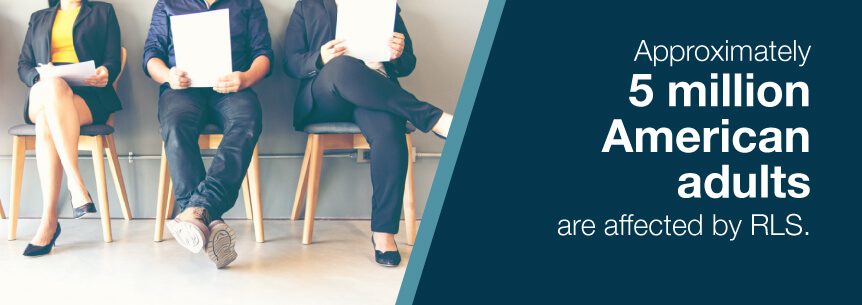
Statistics related to sleep deprivation as a result of RLS provide a clue as to the economic impact of the condition. The National Sleep Foundation reports roughly 28 percent of all adults have missed work because they were too sleepy. More than 52 percent of patients who have RLS symptoms — nearly double the number of people in the general population — have missed work and other events because of sleep problems.
While restless legs syndrome has only recently begun getting headlines and notice outside of the medical community, physicians have been documenting the disorder for centuries.
The works of English doctor Sir Thomas Willis in the 17th century provided the earliest mentions of this previously relatively unknown disease. However, the first cases identifying restless legs syndrome trace back to Dr. Karl-Axel Ekbom in 1943. He had a particular interest in diseases combined with paresthesia and pain in the extremities. In 1945, he published “Restless Legs,” his doctoral thesis studying the disorder closely.
Recent advances in technology and our understanding of the condition have not yet revealed a cure for restless legs syndrome or its many symptoms, but there are many effective treatment options for patients like you to consider.
A variety of treatments commonly used to help patients find relief from RLS symptoms include:
Place a wrap around your feet before going to bed. The wrap applies constant pressure to the muscles in your feet throughout the night, telling the brain to relax your leg muscles and allowing you to sleep at night.
Doctors sometimes recommend non-surgical vein treatments, such as sclerotherapy, to treat varicose veins, which many physicians believe is an underlying cause of RLS symptoms.
Doctors commonly prescribe the following medications to treat RLS symptoms.
These drugs may cause side effects including nausea, dizziness, drowsiness and sedation. You should not take these medications while operating motor vehicles.
There are also things you can do at home to help relieve the impact of symptoms on your daily life, including the following:
While the symptoms of restless legs syndrome are certainly uncomfortable and may interfere with your ability to sleep, as well as your quality of life, the condition itself is not life-threatening. There are plenty of treatments available to help you find relief from the symptoms, so you will be able to live a life as unaffected by the condition as possible.